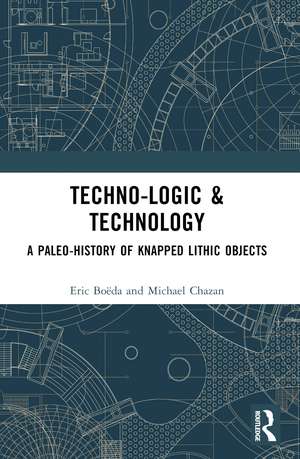Techno-logic & Technology: A Paleo-history of Knapped Lithic Objects
Autor Éric Boëda Traducere de Michael Chazanen Limba Engleză Paperback – 28 noi 2024
Michael Chazan provides a translation of Éric Boëda's authoritative work Techno-logique and Technologie, which draws on the latter's career of research on stone tool assemblages from archaeological sites in Europe, the Middle East, China, and South America, together with a theoretical apparatus influenced by the work of Gilbert Simondon. This book presents a major challenge to all archaeologists studying ancient technology to reconsider how they think about artifacts and how to approach the question of progress through time in human technology. Lithic analysis is a highly empirical field of study that rarely has an impact on issues of broad theoretical interest, and Boëda’s book is a welcome exception. As well as providing contextualising information within the text, the translator Michael Chazan, himself a Paleolithic archaeologist specializing in stone tool technology, includes an interview with the author to help equip the reader to engage with this challenging text.
Chiming with the growth of interest in the work of Gilbert Simondon in the English-speaking world, this book is an important resource for Palaeolithic archaeologists and lithic specialists. It will also be of interest to researchers in material culture studies, technology studies, and human evolution.
| Toate formatele și edițiile | Preț | Express |
|---|---|---|
| Paperback (1) | 311.81 lei 6-8 săpt. | |
| Taylor & Francis – 28 noi 2024 | 311.81 lei 6-8 săpt. | |
| Hardback (1) | 712.99 lei 6-8 săpt. | |
| Taylor & Francis – 31 mai 2023 | 712.99 lei 6-8 săpt. |
Preț: 311.81 lei
Nou
Puncte Express: 468
Preț estimativ în valută:
59.68€ • 64.85$ • 50.17£
59.68€ • 64.85$ • 50.17£
Carte tipărită la comandă
Livrare economică 21 aprilie-05 mai
Preluare comenzi: 021 569.72.76
Specificații
ISBN-13: 9781032416502
ISBN-10: 1032416505
Pagini: 264
Ilustrații: 312
Dimensiuni: 156 x 234 x 16 mm
Greutate: 0.49 kg
Ediția:1
Editura: Taylor & Francis
Colecția Routledge
Locul publicării:Oxford, United Kingdom
ISBN-10: 1032416505
Pagini: 264
Ilustrații: 312
Dimensiuni: 156 x 234 x 16 mm
Greutate: 0.49 kg
Ediția:1
Editura: Taylor & Francis
Colecția Routledge
Locul publicării:Oxford, United Kingdom
Public țintă
AcademicCuprins
Introduction; 1. An epistemological perspective; 2. The techno-logic of evolution: a key to understanding human technicity; 3. The anthropological sense: a paleo-history of the lineages of blade production and blade products in the Middle East during the Pleistocene; 4. Conclusion
Notă biografică
Éric Boëda, a professor at the Paris Nanterre University, is among the pioneers of the French technological approach to stone tool analysis and the most active Paleolithic archaeologists working today. His fieldwork includes projects in Brazil, Mali, Syria, France, and China. His research challenges some of the most established ideas about prehistory, including the timing of the first arrival of humans in the Americas, the evolutionary context of Homo erectus, and the hunting capabilities of Neanderthals. Professor Boëda’s reputation is built equally on his influential work on the theory of technological evolution and the methodology of stone tool analysis.
Michael Chazan is a professor at the University of Toronto. He co-directs the Wonderwerk Cave Research Project, with fieldwork at Wonderwerk Cave and the sites of the Kathu Complex, both located in the Northern Cape Province of South Africa. He is the author of The Reality of Artifacts: An Archaeological Perspective (Routledge, 2019).
Michael Chazan is a professor at the University of Toronto. He co-directs the Wonderwerk Cave Research Project, with fieldwork at Wonderwerk Cave and the sites of the Kathu Complex, both located in the Northern Cape Province of South Africa. He is the author of The Reality of Artifacts: An Archaeological Perspective (Routledge, 2019).
Descriere
Techno-logic & Technology is an ambitious effort to develop a new framework for the study of the development of stone tool technology, with the goal of integrating humanity’s earliest and longest lasting technology into a comprehensive questioning of the interaction between humanity and the material world.
